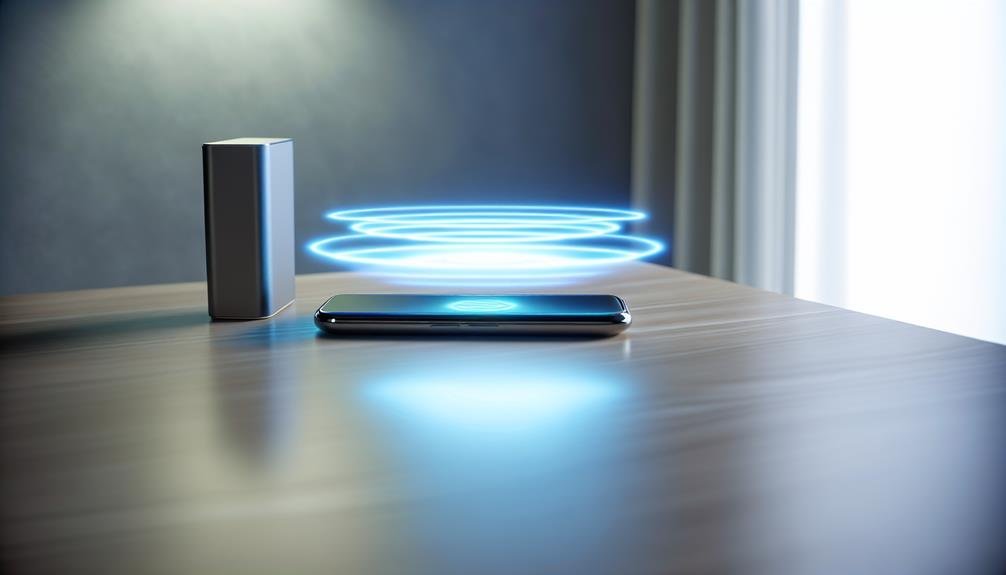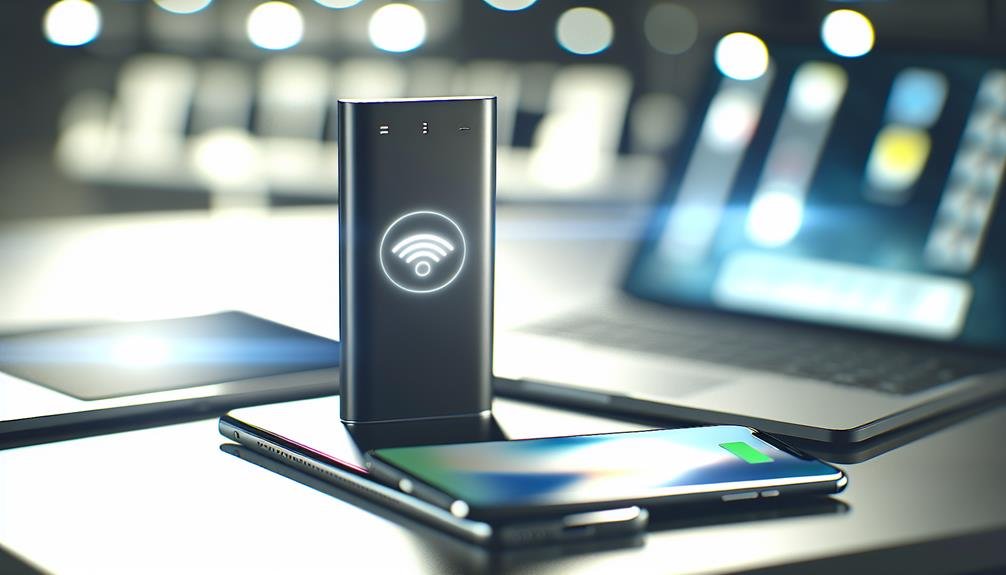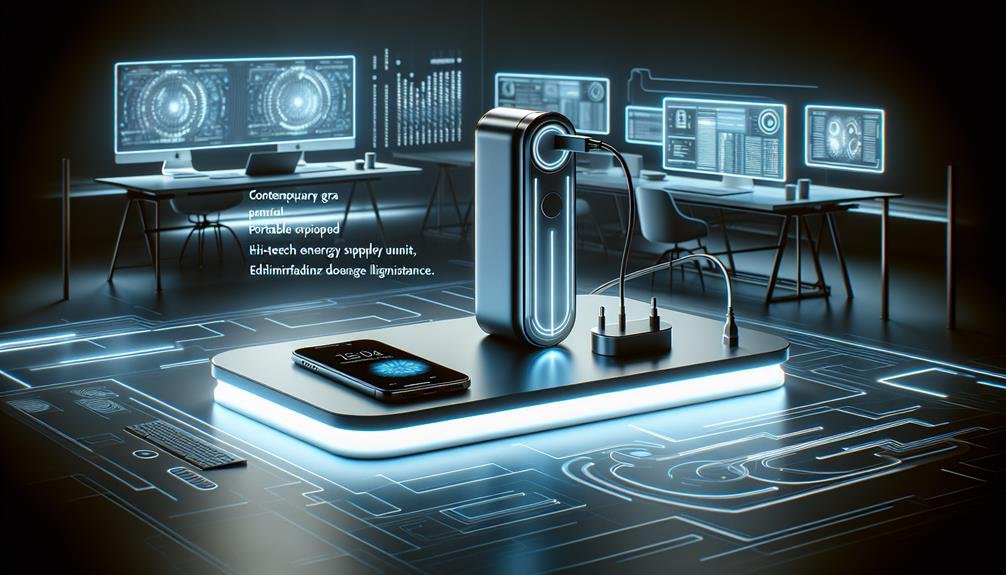Yes, you can charge a power bank wirelessly if it supports wireless charging technology. You'll need to place it on a compatible charging pad, as it relies on electromagnetic fields for energy transfer. Make sure the power bank follows the Qi standard for compatibility and safety. Bear in mind that wireless charging is slower than wired and requires precise alignment. Popular brands like Anker and Samsung offer reliable options. While it reduces wear on ports and offers convenience, the efficiency and charging speed are generally lower. For a deeper exploration, there's much more nuance to contemplate.
Understanding Wireless Charging

Wireless charging, a method that uses electromagnetic fields to transfer energy between two objects, has revolutionized the way we power our devices. You'll find it incredibly convenient, eliminating the need for cables and reducing wear and tear on charging ports. The benefits are clear: you simply place your device on a charging pad, and it begins to charge. This convenience is particularly appealing if you're always on the go.
However, it's important to be aware of the limitations. Wireless charging generally takes longer compared to traditional wired methods. It also requires precise alignment; otherwise, your device might not charge efficiently. Not only that, not all devices are compatible with wireless charging, which can limit its usefulness.
When it comes to safety, wireless charging is generally safe, leveraging well-established electromagnetic principles. It's designed to shut off automatically once your device is fully charged, preventing overcharging. Nevertheless, you should always use certified chargers to avoid the risks associated with counterfeit products.
Wireless Charging Technology
Delving into the mechanics of wireless charging technology reveals how electromagnetic induction powers devices without the need for physical connectors. Fundamentally, a wireless charger uses a coil to create an electromagnetic field, which is then converted into electricity by a corresponding coil in the device being charged. This method offers significant charging convenience and exemplifies recent technology advancements.
When considering portability and ease of use, wireless charging stands out. Traditional wired chargers can be cumbersome, with tangled cords and limited reach. In contrast, wireless chargers simplify the process. Just place your device on the charging pad, and the process begins automatically, reducing wear and tear on ports and cables. This simplicity aligns with the growing trend towards seamless technology integration into daily life.
However, it's pivotal to verify that your wireless charger is certified by recognized safety standards, like Qi certification, to avoid potential hazards such as overheating or electrical malfunctions. Utilizing certified devices ensures that the electromagnetic fields are well-regulated and safe. As you explore wireless charging options, prioritizing safety alongside convenience will help you make informed decisions that enhance your tech experience without compromising your well-being.
Compatibility With Power Banks

When considering wireless charging for power banks, you'll need to understand the wireless charging standards, such as Qi, that your device supports. Different power banks have varying device-specific requirements, so compatibility isn't always universal. Ensuring your power bank meets these standards is essential for efficient and safe charging.
Wireless Charging Standards
Understanding the various wireless charging standards is important for guaranteeing compatibility with different power banks. The most common standard, Qi (pronounced 'chee'), is widely accepted and used by many manufacturers. When selecting a power bank, it's vital to verify that it supports the Qi standard if that's the type your devices use. This guarantees seamless operation and reduces the risk of malfunction or damage.
Another standard you might encounter is PMA (Power Matters Alliance). Although less common, some devices and power banks support this standard. Ensuring your power bank is compatible with PMA can be beneficial if you own such devices. Additionally, you should be aware of the Wireless Power Consortium (WPC), which governs Qi, promoting interoperability and safety.
Safety is paramount when dealing with wireless charging. Confirm that your power bank has undergone rigorous testing and complies with recognized standards. This minimizes the risk of overheating, short-circuiting, or other hazards. Look for certifications and reviews to validate its safety credentials.
Device-Specific Requirements
To achieve optimal performance, it is crucial to verify that your power bank is compatible with the specific charging requirements of your devices. Different devices have varying power needs, and not all power banks are made equal. For example, some power banks might support high-speed charging for smartphones but may not be suitable for laptops or other high-wattage devices.
Understanding power bank compatibility is vital for both efficiency and safety. Ensuring your power bank meets your device's specifications can prevent issues like insufficient charging or potential damage. Wireless charging limitations also play a significant role. Not all power banks support wireless charging, and those that do may not be compatible with every device.
Here's a table to assist you in comprehending compatibility better:
| Device Type | Power Bank Requirement | Wireless Charging Support |
|---|---|---|
| Smartphone | 5V/2A, 10W output | Yes, if Qi-enabled |
| Tablet | 5V/3A, 15W output | Limited |
| Laptop | 19V/3A, 60W output | No |
| Smartwatch | 5V/0.5A, 3W output | Yes, if Qi-enabled |
| Bluetooth Earbuds | 5V/1A, 5W output | Yes, if Qi-enabled |
Current Market Options
When exploring current market options for wirelessly charging power banks, you'll find several popular brands like Anker, Samsung, and Belkin leading the way. Comparing their charging efficiency is vital as it directly impacts the convenience and speed of charging your devices. Evaluating these aspects will help you make an informed decision on the best wireless power bank for your needs.
Popular Wireless Brands
Several leading brands are dominating the current market for wireless power banks, offering a range of options to suit various needs and preferences. These brands emphasize wireless charging benefits like convenience and cable-free experience, ensuring that users can charge their devices safely and efficiently. Here are some of the top wireless chargers you might consider:
| Brand | Model |
|---|---|
| Anker | PowerCore III 10K |
| Samsung | Wireless Charger Pack |
| RAVPower | 10000mAh Wireless |
| Belkin | BoostCharge Power Bank |
Anker's PowerCore III 10K offers reliable performance and robust safety features, making it a popular choice. Samsung's Wireless Charger Pack is tailored for Samsung devices, providing seamless integration and effective charging. RAVPower's 10000mAh Wireless power bank stands out for its high capacity and multiple device compatibility, ensuring you're covered on the go. Belkin's BoostCharge Power Bank combines sleek design with efficient charging capabilities.
When evaluating these options, consider your specific needs and the wireless charging benefits that each brand offers. Safety features like overcharge protection and temperature control are critical, ensuring that you can charge your devices without worry. Choose the top wireless chargers that align with your requirements for a hassle-free experience.
Charging Efficiency Comparison
While popular wireless brands offer a variety of models, it's crucial to assess the charging efficiency of these current market options to ensure you're getting the best performance for your needs. Charging efficiency can vary significantly, affecting both charging time and battery life. Here are four key points to consider:
- Charging Speed: Wireless charging generally provides slower charging speeds compared to wired options. This can be a vital factor if you need your power bank ready quickly. Some models may offer faster speeds, but it's important to verify these claims through reviews and technical specifications.
- Energy Loss: Wireless charging can lead to energy loss due to heat generation and distance between the charger and the device. This inefficiency can result in longer charging times and potential overheating issues, which may impact battery life and safety.
- Charging Limitations: Not all power banks are compatible with every wireless charger. It's essential to ensure your power bank supports the specific wireless charging standards like Qi, and check for any brand-specific limitations.
- Battery Longevity: Regular use of wireless charging can affect the overall battery life of your power bank. Look for models that offer built-in safeguards against overcharging and overheating to extend battery health.
Charging Speed and Efficiency

To understand the charging speed and efficiency of wireless power banks, evaluating both the technology's inherent limitations and the factors that influence performance is crucial. When it comes to charging capabilities, wireless power banks generally lag behind their wired counterparts. The primary reason is the difference in power transfer efficiency. Wireless charging typically achieves around 70-80% efficiency, indicating that some energy is lost as heat, which can impact both charging speed and overall power consumption.
Moreover, the distance between the power bank and the charging pad plays a vital role. Even slight misalignments can further reduce efficiency and slow down the charging process. As a result, you might notice that wireless charging takes considerably longer to replenish your power bank compared to using a traditional cable.
Safety is another important factor. Excess heat generated due to lower efficiency can affect the longevity of both your power bank and the charger. It is advisable to use high-quality, certified wireless chargers designed to minimize energy loss and manage heat effectively. By understanding these aspects, you can make informed decisions about the trade-offs involved in using wireless charging for your power bank.
Pros and Cons
When evaluating wireless power banks, weighing the pros and cons is essential to determine if they're the right choice for your needs. Let's start with the benefits:
- Convenience Factor: Wireless power banks eliminate the need for cables, making them extremely convenient for daily use. You can simply place your device on the power bank and let it charge.
- User Experience: With fewer cords, your user experience improves notably. This reduction in clutter can be particularly beneficial when you're on the go.
However, there are some downsides to keep in mind:
- Cost Comparison: Wireless power banks are generally more expensive than their wired counterparts. If you're on a budget, this could be a noteworthy drawback.
- Environmental Impact: The production process for wireless charging technology is more resource-intensive, which can have a higher environmental impact compared to traditional power banks.
Future Trends

As technology continues to evolve, the future of wireless power banks looks promising with several innovative trends on the horizon. One key trend is the improvement in wireless charging benefits. Future power banks will likely feature faster and more efficient wireless charging capabilities, reducing the time it takes to recharge your devices. Emerging technologies, such as resonant inductive coupling, could enable higher power transfer rates and longer distances between the charger and the power bank, enhancing convenience without compromising safety.
Another significant trend is the impact on battery life. Manufacturers are increasingly focusing on optimizing battery health to ensure longevity. Advanced battery management systems (BMS) will play an essential role in mitigating potential issues such as overheating and overcharging, common concerns with wireless charging. By maintaining the best charging cycles, these systems can extend the lifespan of both the power bank and the devices it charges.
Additionally, we can expect more integration of eco-friendly materials and sustainable technologies in future power banks. This shift not only aligns with global environmental goals but also guarantees that your wireless charging experiences are both safe and responsible. As these trends unfold, you'll find wireless power banks becoming more reliable and user-friendly.
Making the Right Choice
Selecting the appropriate wireless power bank involves assessing key features such as capacity, charging speed, and compatibility with your devices. To guarantee you're making an informed decision, consider the following aspects:
- Capacity: Measured in milliamp-hours (mAh), this determines how much charge the power bank can hold. Higher capacity means more charges but also increased size and weight.
- Charging Speed: Look for power banks that support fast charging protocols like Qualcomm Quick Charge or USB Power Delivery. This ensures your devices are charged efficiently.
- Compatibility: Ensure the power bank supports wireless charging standards like Qi, which most modern smartphones use. Verify it's compatible with your specific devices.
- Safety Features: Opt for power banks with built-in safety mechanisms such as overcharge protection, short-circuit prevention, and temperature control.
A thorough buying guide will help you weigh the advantages and disadvantages of each model. Practical applications vary, so align your choice with your specific needs and consumer preferences. Remember, while a high-capacity power bank offers more power, it might be less portable. Prioritize safety and reliability to guarantee your devices are charged without any risk. By carefully considering these factors, you'll find a power bank that meets your needs and keeps your devices safe.
Frequently Asked Questions
How Do Environmental Factors Affect Wireless Charging of Power Banks?
Environmental factors can greatly impact the efficiency of wireless charging for power banks. By understanding these factors, you can make efficiency improvements, ensuring safer charging practices while minimizing environmental impact. Always consider temperature, humidity, and interference levels.
Are There Health Risks Associated With Wireless Charging?
Imagine EMF exposure as a double-edged sword. While wireless charging does emit radiation, current research shows minimal health risks. However, ongoing studies aim to clarify long-term concerns, ensuring your safety remains a top priority.
Can Wireless Charging Degrade the Battery Life of a Power Bank?
Yes, wireless charging can impact the battery longevity of a power bank. While the convenience and efficiency are appealing, the slower charging speed can generate heat, potentially degrading the battery over time.
How Do I Properly Maintain a Wirelessly Charged Power Bank?
Maintaining your wirelessly charged power bank is a piece of cake. Balance charging frequency—don't overcharge. Use gentle cleaning techniques like a soft, damp cloth to avoid damage. Regularly inspect for any wear to guarantee safety.
What Safety Precautions Should I Take When Using Wireless Charging?
To avoid fire hazards and overcharging, make sure your wireless charger has overcharge protection. Maintain proper distance restrictions to prevent interference. Regularly check your device for overheating and use certified chargers for added safety.



